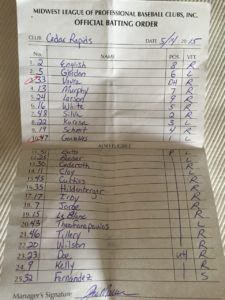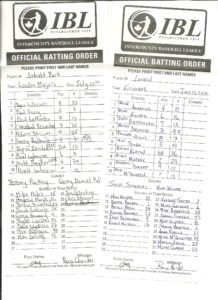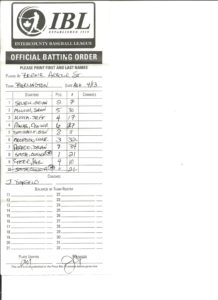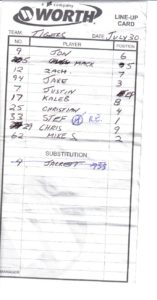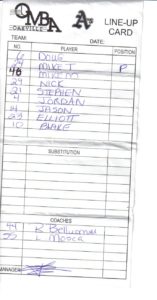For some of our newer umpires, we are going to take a look at a few game preliminaries to demonstrate how each game starts. For more seasoned umpires, do not underestimate the importance of good appearance during these times.
The Plate Meeting
Prior to each game, the umpires shall enter the field no fewer than five minutes prior to the scheduled starting time and proceed directly to home plate to exchange line-ups and cover the park ground rules. For fields with complicated ground rules and/or if the game will have a national anthem, five minutes is not enough and umpires are advised to arrive at the plate earlier so the game may start on time.
Once at home plate, the plate umpire will stand directly behind home plate, with the base umpire(s) opposite, facing each other. It is not necessary for the plate umpire to call “coaches” or “coaches and captains” upon arrival at the plate; each team’s manager should be aware that once the umpires have arrived, it is time for the plate meeting. Should there be an excessive delay by one or both teams, it would then be appropriate to ask the managers to come to the plate for the plate meeting. Upon their arrival, the managers (and any additional guests) shall stand in their respective batter’s boxes, bringing with them no fewer than two identical copies of their line-up. If there are three or more umpires, it is acceptable for the base umpires to stand either directly across the top of the batter’s boxes, or to angle themselves in a manner so as to form a semi-circle.
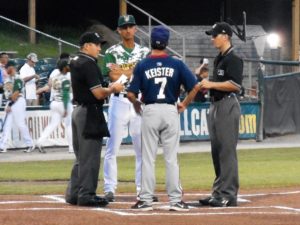
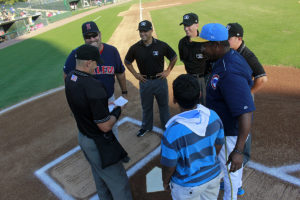
In recent years, it has become common practice for the home team to receive a pep talk from their manager and then break for their positions on the field, at which point the manager comes to home plate and usually requests to do the plate meeting off to the side of home plate. DO NOT permit this to occur. Should the home team choose to start the game this way, the plate meeting shall still occur at home plate, for several reasons. Primarily, safety of the umpires and coaches. Second, it is extremely disrespectful to the umpire crew and visiting team. Third, it provides the home team an advantage, as they have extra time to warm-up for the start of the game. And fourth, it actually eliminates the umpire’s ability to correct a potential obvious error (addressed later) in the home team’s line-up card.
Umpires should introduce themselves by name to each manager, making it a point to learn the name of each manager as well. If a coach should introduce themselves by last name (i.e. “Hi, I’m Coach Smith”), be sure to ascertain their first name in a polite and professional way. While a coach can direct his team to address them in any manner they so choose, they do not have this authority over umpires and it is extremely unprofessional, and an intimidation tactic when directed to younger umpires, for a coach to expect an umpire to address them in this manner.
If a coach or player has come to the plate meeting instead of the manager, the umpires should ensure they are aware as to who the manager of the team is. If there are line-up cards presented, the plate umpire will check and distribute both line-ups (see a coming post for a review of line-up card procedures). In many HBUA games, teams are not required to provide the umpires with a line-up card. The plate meeting would then proceed to discussing ground rules.
The discussion of ground rules should not be taken lightly. Every year in baseball, protests occur because of situations that occur, which may have been prevented by a thorough review of the ground rules prior to each game. Plate umpires, regardless of crew seniority, should take charge and be the one to deliver the ground rules. The discussion of ground rules should begin with any features behind home plate and proceed around the diamond. Each park regularly officiated at by HBUA umpires is listed under the “Venues” tab and contains park ground rules, as established by the HBUA and agreed upon by the HDBA (or, in the case of Bernie Arbour Stadium, Minor League Baseball, from it’s time as a stadium in the New York-Penn League). Be sure to also review the “Universal Ground Rules” page, as several HDBA parks are well-built and have no unique ground rules beyond those covered in the universal rules. Do not discuss any playing rules while going over the ground rules however, if the game is to be played under any kind of time limit, it would be appropriate to inform the attendees of the plate meeting of those curfew times as well as which umpire has the official watch.
Once the discussion of ground rules and curfew, if applicable, has been completed, take a moment to ensure neither manager has any questions. If there are no questions, it is time to conclude the plate meeting.
The National Anthem
For games in which a national anthem is played before the game, umpires shall stand at attention facing the flag with their heels together, head erect, left arm extended down the leg, and right hand over the heart. If no flag is presented, the umpires shall face centre-field. There is to be absolutely no talking, laughing, spitting, or chewing during the playing of the anthem.
In the two-umpire system, each umpire will stand behind each batter’s box. In the three-umpire system, the base umpires shall stand behind each batter’s box with their toes on the back line of the box, with the plate umpire behind home plate. In the four-umpire system, the plate umpire shall stand left-of-centre of home plate, with the third base umpire to his left and the second base umpire to his right. In the event a six-umpire crew is used, the infield umpires should use this same alignment, with the left-field and right-field umpires standing on the extreme left and right, respectively. It is permissible for the catcher to join the umpires at home plate. In the two-umpire system, he shall stand between the umpires. In the three-umpire system, the catcher shall stand between the plate umpire and the first-base umpire. In the four or six-umpire system, the catcher shall stand between the plate umpire and second-base umpire.
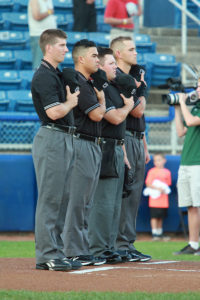
Four-umpire system national anthem with no catcher
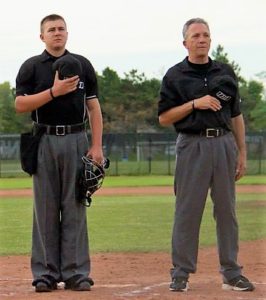
Two-umpire system national anthem with no catcher at Bernie Arbour Stadium (flag behind home plate)
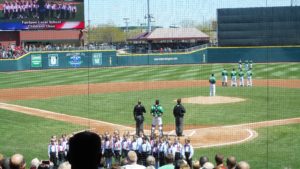
Two-umpire system national anthem with catcher
Once the national anthem has concluded, if the players are on the field, the umpires shall break from home plate to their positions. In all other cases, the umpires shall not leave the plate until the defensive team takes the field.

